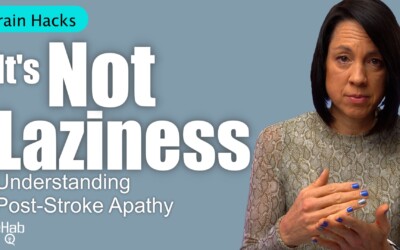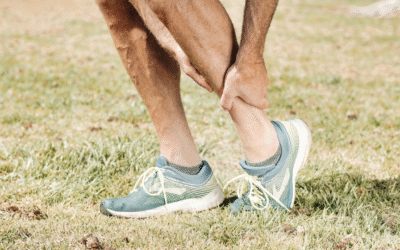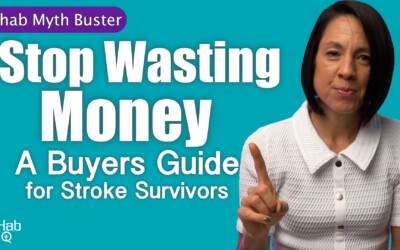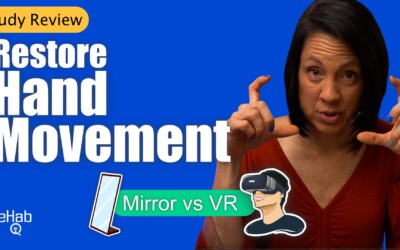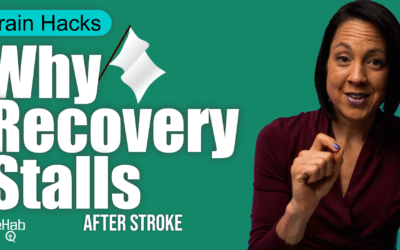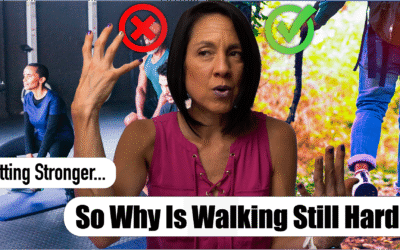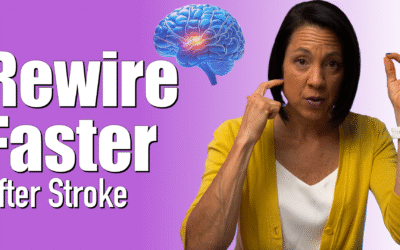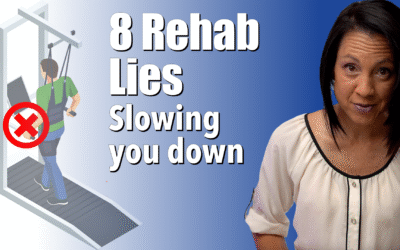Why Your Knee Buckles—and How to Regain Control
Say Goodbye to Knee Giving Way and Hello to Confident Walking
What Is Knee Buckling? 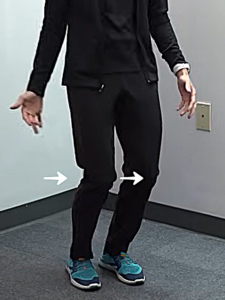
Knee buckling refers to a sudden, unexpected loss of stability in the knee joint, often described as the knee “giving way.”
It can happen while standing, walking, or going up and down stairs. This issue may stem from muscle weakness, poor coordination, or involuntary muscle patterns following a neurological injury or condition.
What Causes Knee Buckling?
1. Weakness – Often in the quadriceps (the muscles that straighten the knee) or the plantarflexors (calf muscles that point the foot down). This is common in peripheral neuropathies like diabetes.
2. Lack of Eccentric Control – Eccentric control is the ability of muscles (especially the quads) to lengthen while contracting. For example, this is needed when going down stairs.
3. Inability to Dissociate – After a stroke, the brain may struggle to make the legs perform separate movements. This may cause buckling even in the stronger leg.
4. Abnormal Synergy Patterns – Like the flexor synergy pattern, where involuntary movements cause the leg to bend unexpectedly, similar to the reflex babies use.
Flexor Withdrawal – An automatic reaction where the leg pulls away in response to a sensation on the sole of the foot.
5. Spasticity – Involuntary muscle contractions that occur due to brain or spinal cord damage. Spasticity is different from dystonia and can make coordinated movement difficult.
How Bracing Can Help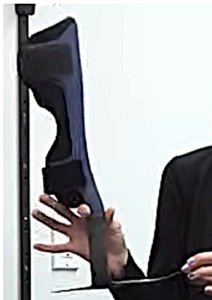
1. Floor Reaction AFO (Ankle-Foot Orthosis)
This brace helps by pushing your shin bone backward, giving your knee more support when you stand or walk.
✅ Best for:
- Knee buckling from weak quadriceps
-
Flexor synergy patterns (common after a stroke or brain injury)
🦶 Why it works:
It supports your knee by adjusting your ankle position—addressing the problem from the ground up.
2. Knee Immobilizer (Training Tool) 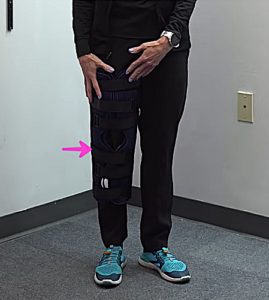
This brace keeps your knee locked straight to help retrain your leg muscles.
✅ Best used for:
-
Weakness in the quads
-
Early stages of spasticity
-
Difficulty making both legs move differently (poor dissociation)
⚠️ Important:
This is not for regular walking. It’s a short-term training tool to build better control during early rehab.
Exercises to Improve Knee Stability
I. Strengthening the Calf Muscles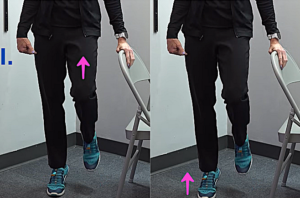
- Stand using a chair or anything stable for support.
- Do single-leg toe raises.
Modification 1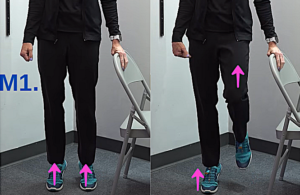
- Go up with both feet
- Lift one foot
- Lower slowly.
Modification 2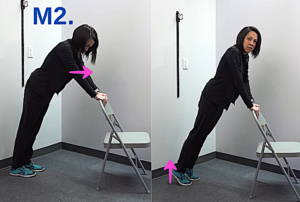
- Step back from the chair
- Lean forward
- Raise heels without bending the knees.
II. Sit to Stand (STS) for Quad Strength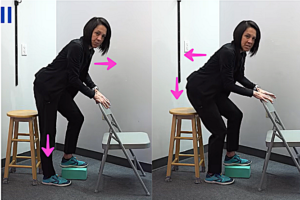
- Sit on a stool holding onto a chair for stability.
- Place your non-working leg on a yoga block.
- Shift weight to the working leg.
- Lean forward and push up (concentric).
- Lower down slowly (eccentric).
Progression: Begin on a high stool and progress to lower surfaces.
III. Step Training with PVC Frame
A. Step Up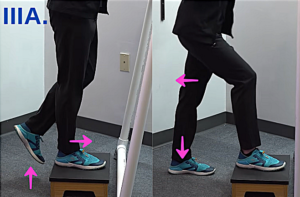
- Stand in front of a wide step or low platform.
- Step up using your stronger leg. This is the “push” part where your muscles are doing most of the work. (concentric)
- Step back down slowly and with control. (eccentric)
B. Step Down Over the PVC Frame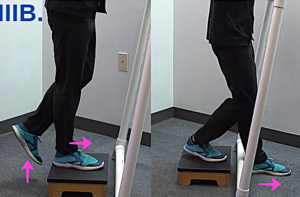
- Step up like before.
- Now, carefully step forward and down over the PVC frame. (concentric)
- This part focuses on controlled movement as your leg muscles slowly lower your body. (eccentric)
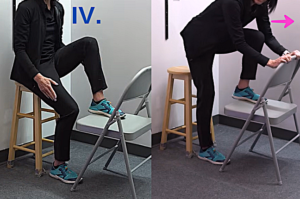 IV. Dissociation Training
IV. Dissociation Training
- Sit on a high stool with your weaker leg bent over a chair in front of you.
- Place your hands on the chair for support and balance.
- Try to perform a sit-to-stand, keeping one leg bent and the other straight the entire time.
➡️ The key is to make sure your leg positions are in the extremes—one bent, one straight—to truly work on dissociation.
Progression: Switch leg positions and repeat the exercise with the opposite setup.
Too difficult?
-
-
Start in standing with a knee immobilizer on the weaker leg.
-
Conclusion
Struggling with knee buckling can feel frustrating and even a little scary—but it doesn’t have to stay that way. When you understand why it’s happening, whether from weakness, nerve issues, or changes after a stroke, you can start building a path forward. The right combination of braces, targeted exercises, and support from your rehab team can make a real difference.
Take the first step toward steadier, more confident walking—your recovery is worth it.
Articles you may be interested in
Stroke Recovery and Apathy: What It Is and How to Overcome It
What’s Really Going On When Motivation Disappears After Stroke Recovering from a stroke is a journey that requires strength, patience, and persistence. But for many stroke survivors, the hardest part isn’t weakness, fatigue, or memory loss. It’s something less visible...
Spasticity or Weakness? Understanding Your Stroke Symptoms
How Can You Tell If It’s Spasticity or Weakness After Stroke? https://youtu.be/3QR9D4rBNhc If you’ve had a stroke, you’ve probably heard a few of these words tossed around: spasticity, weakness, stiffness, foot drop. They might all sound similar, but they each tell a...
Master Ankle Mobility: Exercises for Better Walking
Ankle Mobility Exercises to Boost Balance and Walking Ankle stiffness is one of the most common issues people face after a stroke or any neurologic injury. It can make walking harder, cause your toes to catch, or even affect your balance. But here’s the thing,...
Improve Focus and Attention After Stroke
Stroke Recovery: How to Regain Focus and Attention Faster https://youtu.be/ul0wUgXravo When most people think about recovery after a neurologic injury like a stroke, brain injury, or MS, they often focus on the physical side. Strength. Repetitions. Muscle activation....
Should You Spend Money on Stroke Rehab Devices?
Are Trendy Rehab Treatments and Devices Worth It? Here's My Honest Take https://youtu.be/T69LavHLdIQ Should you be spending your hard-earned money on all those rehab devices popping up in your social media feed? And if so, which one is actually worth it? The truth?...
Restore Hand Movement After Stroke with Mirror Therapy
Mirror Therapy & VR: Stroke Recovery for the Hand https://youtu.be/OeThZMwJt40 If you’ve lost movement in your arm after a stroke, you’ve probably wondered: “Is my arm just weak, or is something deeper going on in my brain?” That’s not because your muscles forgot...
Stroke Recovery Plateau: What to Do
Why Stroke Recovery Stalls and How to Push Through Recovery may feel stuck, but progress is still possible. Here’s how to keep improving after a plateau. https://youtu.be/w6xZZpx7tDY Recovering from a stroke or neurologic injury can feel overwhelming. Walking,...
Why Your Stroke Exercises Aren’t Helping and How to Fix It
Stroke Recovery Tips: When Exercises Don’t Seem to Work https://youtu.be/9r06T9gtsYc Is it possible to be making progress after a stroke or neurologic injury and still feel like your movement is getting stiffer, heavier or just plain harder?Absolutely. And let me tell...
Boost Stroke Recovery: 3 Brain Habits That Actually Work
Want to Rewire Your Brain Faster After Stroke? Try These 3 Habits https://youtu.be/iFcjDtHrrwM If you’ve been on this neuro-recovery journey, you know it can feel like progress is slow. You do your exercises, you follow instructions, but sometimes your brain seems…...
Stroke Recovery Myths Debunked: The Truth About Healing
8 Neuro Rehab Myths That Are Holding You Back (And What to Do Instead) Debunking Common Myths About Neurologic Recovery https://youtu.be/chTfi1d5kn4 If you’ve ever been told that your recovery after a neurologic injury has an expiration date, or if your physical...


